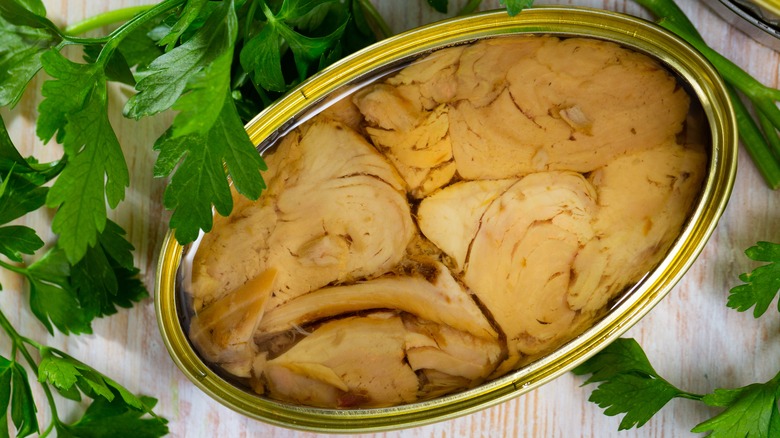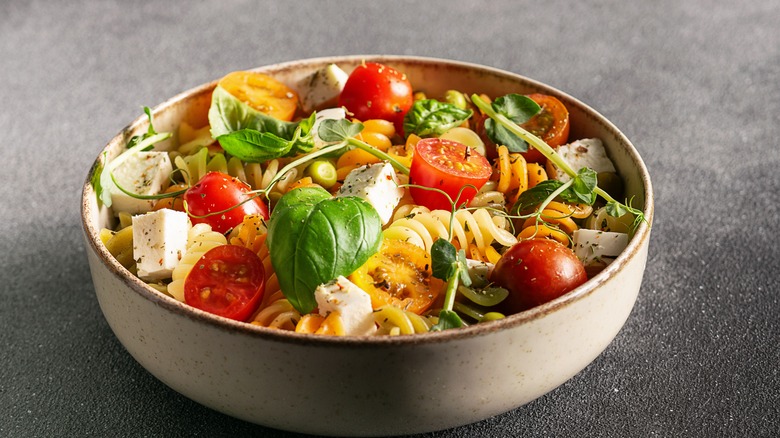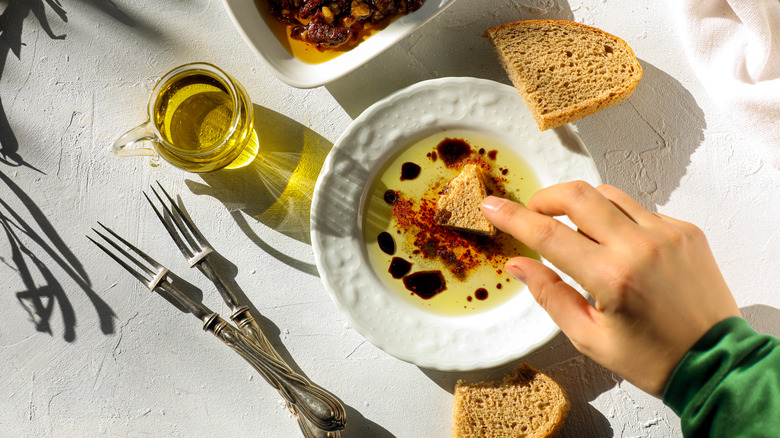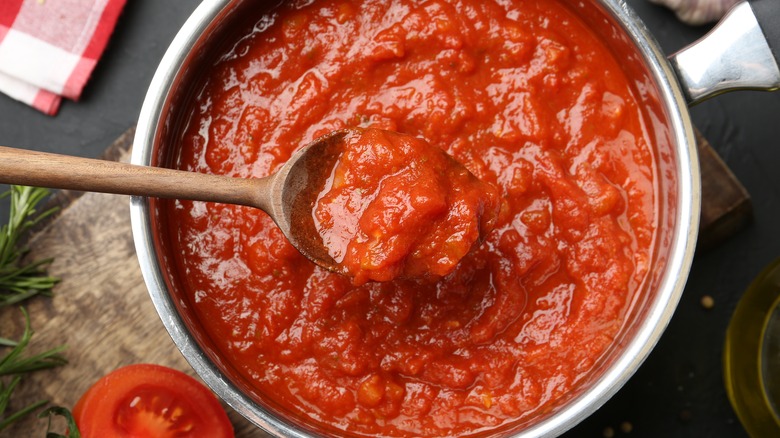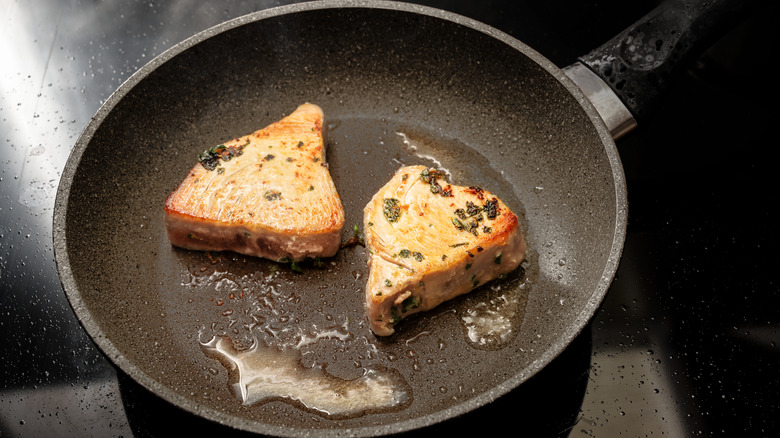5 Ways You Can Use The Leftover Oil From Canned Tuna
The first step for most people when crafting a dish using canned tuna is to thoroughly drain the fish. That's all well and good if you're using tuna packed in water, but pouring oil from canned tuna down the sink is a waste of a very valuable ingredient. Canned tuna can be packed in many varieties of oil, including olive, vegetable, and soy oil, which means you can use it in pretty much any application you would use any other cooking oil. The difference is that the oil from canned tuna has the benefit of being infused with delicious, savory seafood flavor — and sometimes other ingredients, including chile peppers and citrus fruits. (Smoking the fish is another way to imbue the oil with intense flavor.)
If you want to start cooking with tuna oil, first grab an airtight container to keep it in, like a glass jar or squeeze bottle. Then, once you have a bit of oil left over from a tuna can, use cheesecloth or a fine mesh sieve to remove any impurities. There isn't a ton of oil in each can, but a little goes a long way. Still, if you're the kind of home cook who likes to make tuna salad in bulk, you should collect a decent amount in no time.
Use the oil as a dressing
With a bit of canned tuna oil, you can quickly whip up a delicious dressing that's perfect for salads, pastas, and more. You can turn any cooking oil into a simple dressing, but for the best results, you may want to use tuna that's canned in olive oil. There are many dressing recipes that use olive oil as a base, so you can simply swap in the tuna oil and adjust the measurements as needed. For a super quick dressing, add the tuna oil, lemon juice, plus salt and pepper to a resealable container. There should be less juice than oil. Some dressings use a 1-to-3 ratio, but for this fish-infused oil, consider going with a more acidic 2-to-3 ratio. So, if you have three-quarters of a cup of oil, you'd want to balance it with half a cup of lemon juice. To emulsify the dressing, close the container and shake vigorously until everything is thoroughly combined.
The oil's fishiness will add a satisfying twang of aquatic umami to whatever salad you drizzle it over. Of course, it goes especially well with tuna. Mixing the homemade dressing into a dish like pasta that has been upgraded with canned tuna is a cheap and easy way to ensure you get every last bit of flavor out of your canned fish. If you do turn the tuna oil into dressing, store it in the refrigerator and use it within four days for optimal freshness.
Fry up your favorite foods
One of the most straightforward ways you can make the most of excess tuna oil is to use it as an ordinary cooking oil to fry up everything from eggs to onions. Again, olive oil is probably your best bet. That's because, besides the bonus of the extra fish flavor, olive oil is one of the most nutritious cooking fats around, thanks to its high levels of antioxidants. You can use other types of oil, but be aware of their smoking points so you don't flambé your toast (soybean and canola oils are comparable to olive oil, while sunflower oil should be used cautiously). To use tuna oil as a frying agent, all you have to do is collect it as you drain the fish until you have enough to properly fry up whatever you're cooking. From there, the possibilities are endless.
Eggs are one of the go-to foods when it comes to frying, and they will pair excellently with the tuna flavor of the oil. For a meal that's packed with savory fish flavor, try frying a couple of eggs with the tuna oil as you normally would. Then, serve them over a salad tossed with the canned tuna and drizzled with your homemade tuna oil dressing!
Turn the oil into a sophisticated dip
Since the oil used to pack tuna is itself packed with flavor, you can transform it into an elevated dip that's perfect for parties or as an appetizer. All you have to do is save up enough oil to fill a shallow dish or bowl, then top it with the herbs and spices of your choosing. You could keep it super simple with just a bit of salt and pepper, give it an Italian twist with garlic and oregano, or go for more of a Mediterranean vibe with dill and rosemary.
This dip is perfect for soft, absorbent breads like naan or focaccia, as well as crusty loaves like baguettes. To take it to the next level, serve with baguette slices that have been toasted in a pan with the tuna oil. You could also try it with crudité vegetables like carrots and celery, or use the flavored oil to give a glossy finish to pizza, flatbread, or anything else that could use an extra bit of flavor.
Upgrade soups and sauces
Tuna oil is the perfect ingredient for adding richness and depth to practically any dish, including tons of soups and sauces. Basically, if a recipe ever calls for olive oil, you can use the olive oil packed inside a tuna can instead to instantly add a burst of umami flavor and a bit of extra nutrition. For example, the tuna oil will be a great addition when upgrading standard garlic aioli for one with the citrusy zing of lemon, since the fish pairs so well with both of those flavors. It would also work perfectly as the base for puttanesca sauce, which traditionally includes anchovies and can be made with canned tuna.
Whether added during the cooking process or after, a drizzle of tuna oil will expertly upgrade a bowl of soup so long as it's mixed with complementary flavors. It can delicately cut through and round out acidic flavors like citrus and help bulk up hearty stews made from ingredients like beans or chickpeas. Try adding a drizzle of tuna oil to roasted butternut squash soup and see if you can taste the difference!
Saute or sear fish and veggies
When sauteing or searing food, the ingredients are cooked by the high heat of the flat-bottomed pan, and only require a small amount of oil so nothing sticks. That means the teaspoon or so of oil in the average can of tuna is perfect for sauteing any type of seafood that could do with a little tasty tuna boost.
This is a great method for cooking fish, especially when using fillets with the skin attached — the flavorful tuna oil is the perfect conduit between the hot pan and the crispy fish skin, resulting in an extraordinary final dish. Add a ramekin of saffron-infused rouille (another mayonnaise variant) made with the tuna oil, plus some diced peppers and onions that have also been sauteed in fishy oil as a side dish, and you've got yourself a multifaceted seafood smorgasbord.
Sometimes, cooking at home means making the most of what you've got. So as you continue to find ways to upgrade canned tuna, don't forget to upgrade the oil as well.
